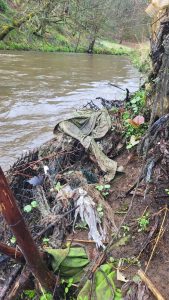Fly-tipping & Japanese knotweed is a big problem in the UK
Because it leads to the spread of this invasive species. Fly-tipping is the illegal dumping of waste on public or private land. And it often includes materials such as soil, rubble, and plant cuttings. If plant material is present in the waste that is fly-tipped, it can quickly establish itself in the new location, creating a new infestation.
Furthermore, some people may throw their rubbish into large stands of Japanese knotweed. Because they believe it will hide the waste. However, this is not a responsible or effective method of waste disposal, and it can have serious consequences for the environment and public health.
This can lead to a new infestation
Fly-tipping & Japanese knotweed moreover, Japanese knotweed is an extremely resilient plant. Furthermore, it can grow in a wide range of soil types and conditions. It spreads by producing new shoots from its wide root system, which can extend up to 7m from the main stem. This means that if Japanese knotweed is brought to a new area. It can quickly colonize the entire site, out-competing native vegetation and causing some environmental damage.

Japanese knotweed growing in rubbish
It will quickly grow from a small Fragment of Rhizome
Moreover, when Japanese knotweed is fly-tipped, it is often mixed with other waste materials. Making it difficult to detect and remove. This means that even small amounts of Japanese knotweed rhizome can lead to a new infestation. If the fly-tipped waste is not removed promptly. Japanese knotweed can spread to neighbouring properties, making it even more difficult to control.
In addition to the environmental damage caused by Japanese knotweed. It can also have a significant impact on property values. Japanese knotweed is known to cause damage to buildings and infrastructure. Moreover, its presence can make it difficult to sell or rent a property. This means that fly-tipping of Japanese knotweed can have a negative impact on both the environment and the economy.
It is important to raise awareness
To address the problem of fly-tipping of Japanese knotweed. It is important to raise awareness of the issue and encourage responsible waste disposal. This may involve working with local authorities, and waste management companies. And also community groups to promote the proper disposal of waste and the early detection and removal of Japanese knotweed. Therefore by taking action to prevent the spread of Japanese knotweed, we can help to protect the environment. Additionally, preserve property values for future generations.

Japanese knotweed growing in a Harthorne hedge
As mentioned earlier. Japanese knotweed is an invasive species that can quickly establish itself in a new location and outcompete native vegetation. When waste is fly-tipped into a stand of Japanese knotweed, it can create an ideal environment for the plant to spread and grow. The waste can provide a source of nutrients for the knotweed. Additionally allowing it to grow even more vigorously and outcompete other plants in the area.
The Ecosystem can be altered
This can have a serious impact on the local ecosystem. Native plants and animals may be displaced or even eliminated by the knotweed. Moreover, the presence of fly-tipped waste can attract pests such as rats and insects, which can pose a risk to public health.
Throwing rubbish into large stands of Japanese knotweed
Is also illegal and can result in fines and other penalties. It is important to dispose of waste responsibly, either by using proper waste management facilities or by hiring a licensed waste disposal company. By taking these steps, we can help to protect the environment. This will ensure that our waste is managed safely and responsibly.
Clearing fly-tipped waste can sometimes result in the spread of Japanese knotweed. This is because the plant’s rhizomes, or underground stems, can easily break off and spread to new locations if they are disturbed. When waste is cleared from a site, rhizomes or fragments of the plant may become entangled in the waste and be transported to a new location.
This is a concern for local authorities and waste management companies, who have a responsibility to manage waste safely and responsibly. To mitigate the risk of spreading Japanese knotweed during waste removal. Several best practices can be followed.
These include:
- Conduct a site survey before removing waste to identify any Japanese knotweed present. And taking appropriate measures to control its spread.
- Ensuring that all waste removal personnel are trained in identifying and managing Japanese knotweed. and providing them with appropriate equipment to prevent the spread of the plant.
- Segregating and disposing of waste that is contaminated with Japanese knotweed separately from other waste. This will prevent the spread of the plant to new locations.
- Implementing measures to prevent the spread of soil or other materials that may be contaminated with Japanese knotweed. Such as using temporary matting or wooden boards to protect the ground during waste removal.
By following these best practices,
local authorities and waste management companies can help to minimize the risk of unintentionally spreading Japanese knotweed during waste removal operations. This can help to protect the environment and prevent the further spread of this invasive plant species.
Therefore If you are out walking and see the waste that has been fly-tipper near Japanese knotweed it is always best practice to notify your local council, You can report it to Report Japanese Knotweed – Soilutions
